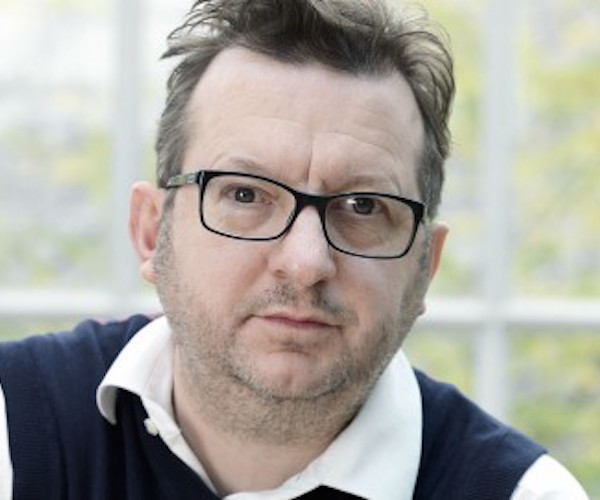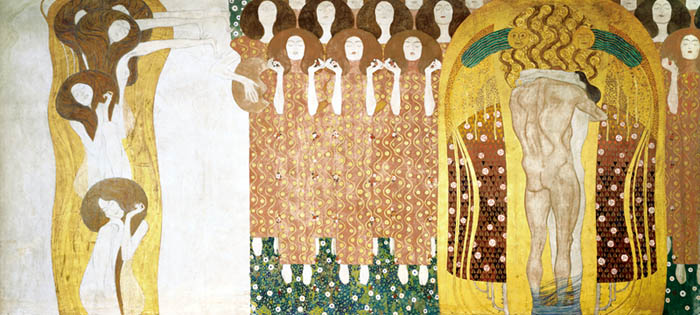Rethinking the Repertoire #10 — Mark-Anthony Turnage’s “Frieze”
It is one of the enduring ironies of classical music that so much of today’s repertoire was written by such a small number of people. This post is the tenth in a multipart Arts Fuse series dedicated to reevaluating neglected and overlooked orchestral music. Comments and suggestions are welcome at the bottom of the page or to jonathanblumhofer@artsfuse.org.

Composer Mark-Anthony Turnage — his “Frieze” is, without a doubt, one of the major symphonic scores of our century. Photo: Philip Gatward.
By Jonathan Blumhofer
How does an artist reckon with the received repertoire of his or her discipline? That’s one of the most fundamental aesthetic question you might pose an author, painter, playwright, poet, or composer, because it gets directly to the crux of what they do and why. Interestingly, in recent years (as the New York Times recently pointed out) this very practice has become something of a fad for orchestras and commissioning agencies, specifically asking composers to “reply” to canonical works with pieces of their own. Granted, some of these scores leave better (and bigger) impressions than others and the worst of them might be no more than gimmicks.
But the best of them, if they somehow overcome that shadow of past influence, can often speak directly and powerfully. For instance, John Adams’ Absolute Jest and First Quartet reveal remarkable connection between the techniques and materials of late Beethoven and what we might call late-middle- (or early-late-?) period Adams. Similarly, Anna Clyne’s Night Ferry crafts a haunting bridge between our time and Schubert’s.
You can say much the same for Mark-Anthony Turnage’s Frieze, a Royal Philharmonic Society commission intended as a “response” to another RPS commission from way back, Beethoven’s Ninth Symphony. Composed in 2012 and premiered the following year at the Royal Albert Hall in London, Frieze is a piece whose four movements allude in various ways to Beethoven but also bear out Turnage’s stated ambivalence about the Ninth (“I don’t like Beethoven’s Ninth all that much,” he complained to the Daily Telegraph, its finale, especially, being “so weirdly stop-and-go with the Turkish march and the fugue”). Given that, plus Turnage’s background in jazz, his penchant for exploring dark emotional terrain in his music, and his no-holds-barred energy, it’s perhaps not a big surprise that Frieze is a score boasting a certain degree of edginess.

“Beethoven Frieze,” Gustav Klimt.
Appropriately enough, too, Frieze’s direct references of Beethoven’s Ninth come only obliquely – there are a couple of quotations, the clearest of them appearing in the opening fifths of the first movement and the second theme of the third – but draws much of its inspiration (as well as its title) from Gustav Klimt’s extraordinary Beethoven Frieze. The reproduction of rising mythical figures, Turnage told the Telegraph, “really stuck in my mind.” How, exactly, these visual impulses informed the musical result is something of an open question (and its worth pointing out, too, that Frieze is decidedly less “heroic” in scope than either the Ninth or the Klimt, clocking in at only around twenty minutes) but there is a compelling directness to Turnage’s writing in Frieze and a clarity of expression that is shared between the works of all three creators.
You hear this from the very beginning. Its first movement, as noted above, begins with those sustained perfect fifths, but it’s not long before a sweeping, chromatic melody starts winding its way around and through them. As this angular tune develops, granitic riffs and a striding bass line (again, made up of fifths – this time ascending, not static) assert themselves. Eventually, a quieter (if not exactly gentler) section emerges, highlighted by a solo trumpet heard over an undulating, syncopated string accompaniment.
These three ideas – the Beethoven- and the jazz-inspired – are the primary building blocks of the movement. Turnage doesn’t treat them, though, in a typically Beethovenian fashion. If the movement’s first half was expository, the second is nearly entirely development. It’s all highly contrapuntal (the solo trumpet theme proves remarkably malleable) and increasingly aggressive in character, culminating in a return of the open fifths motive. Only now, instead of the pure interval heard before, what’s give are essentially thuds of tone clusters answered by mysterious woodwind chords. And then the movement ends. It’s all terrifically unsettling.
The second movement continues the close of the first’s play of mystery. This is a scherzo in all but name, punctuated by eerie silences and figures that are fragmented to an almost absurd degree. Turnage’s writing for low instruments (namely contrabassoon, tuba, and contrabass) is particularly menacing. A lyrical, contrapuntal middle section offers a richly Beethovenian play of contrasts but that lighter mood hardly lasts: the pesky opening figures return and the movement ends with a shudder – like a skeleton smiling through the moonlight.
In the third movement, the musical character turns from threatening to nervously peaceful. Here, Turnage presents himself as something of a 21st-century Vaughan Williams crossed with, maybe, Shostakovich. The opening section is lyrical and desolate, with the (again, contrapuntal) melodic writing scored for violins in their upper registers and high winds. There’s an aimless quality to Turnage’s writing here – it’s kind of the aural equivalent of a bubble being carried along by a soft breeze – even as the melodic bits are peppered with bursts of percussive chords.
A new theme, though, does away with that atmosphere, if only for a little while. This tune is played by violins and flutes and sounds like a trope on one of the flowing variations in the penultimate movement of Beethoven’s Ninth, even if the syncopated accompaniment here ensures that the aura is more disturbed. And, indeed, that latter quality intrudes further. The theme’s counterpoint turns darker, first recalling the middle section of the second movement and then reaching its apex with a reprise of the first movement’s final, tolling chords, now slightly varied and extended. A bit of a driving, jazzy interlude leads to a reprise of the first two themes, their initial disquietude now augmented by what’s just come.
With the finale, though, Turnage clears the air, offering a brand of stop-and-go fun, that, in many regards, isn’t far removed from the jerky nature of the “Ode to Joy’s” fourth movement. Only here, the intoxicating brotherhood of Schiller’s verse is exchanged for an earthier, more primal experience, everything coming across as slightly (or more) inebriated and owing a strong debt to big-band jazz and the club scene.
The movement begins with a quick series of syncopated chords followed, in short order, by a wildly meandering tune tossed between strings and winds. These two ideas alternate before reminiscences of the first movement (chorale-like gestures, a recurring bass line, etc.) lead to a blazing, exuberant chorus. All three of these types of music are then developed and repeated in various guises over the ensuing couple of minutes before an extended series of syncopated figures – taking up almost four full pages of the full score – close out Frieze in a stomping fury.
So, why Frieze? Well, it is, without a doubt, one of the major symphonic scores of our century. Its expression is direct, its materials memorable, its orchestration brilliant and assured, and – on top of all that – it offers a bracing dose of its composer’s personality. Best of all, it provides an honest and unsentimental commentary on one of the West’s most daunting cultural objects. That it’s never intimidated by the focus of its critique is one thing. This it stands on its own legs so strongly as to not be overshadowed by it is another entirely. It is, in its way, a declaration of Turnage’s artistic credo, one that’s in sundry ways rooted in the past while also being thoroughly contemporary, engaging the mind and the heart. That’s a tall order to fill and here, at least, Turnage managed the task impressively.
Jonathan Blumhofer is a composer and violist who has been active in the greater Boston area since 2004. His music has received numerous awards and been performed by various ensembles, including the American Composers Orchestra, Kiev Philharmonic, Camerata Chicago, Xanthos Ensemble, and Juventas New Music Group. Since receiving his doctorate from Boston University in 2010, Jon has taught at Clark University, Worcester Polytechnic Institute, and online for the University of Phoenix, in addition to writing music criticism for the Worcester Telegram & Gazette.
Tagged: Beethoven, Frieze, Mark-Anthony Turnage, Ninth Symphony

Fantastic use of critique, the web, and expertise. Reading and listening – like getting small private class. This ia a model that goes beyond any other arts journal! Thanks for the offering